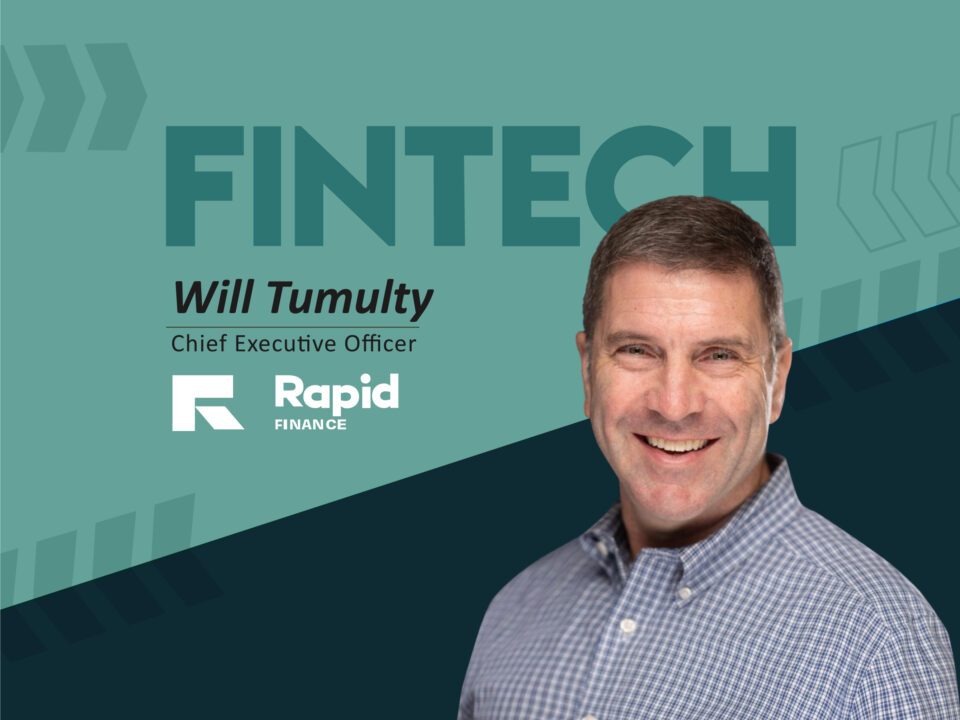Hi Will, welcome to our Fintech Interview Series. Please tell us about your fintech journey so far.
The fintech journey of Rapid Finance has been an interesting one in that there are a lot of financial technology companies that have started on the technology side and then worked to figure out how to apply that technology to a financial problem.
We came at it from the opposite direction in that we have been doing the financial side — particularly in small business lending — for a long time and have injected technology into our business over the years, to make our processes and decisioning faster, more streamlined operationally, and more effective for our customers.
That’s actually a little bit atypical in our industry, where often, we see someone design and build technology and then look for an application or use case for that technology. Too often – and unfortunately — what we also see is that these organizations lack a substantial appreciation for the level of risk – whether it’s payments risk, lending risk, or regulatory risk – that exists in the industry, and they run into trouble on the credit or regulatory side with portfolios that can collapse and lose money.
For our fintech journey, we had been building out our own platform over the years as we grew our financial business and our overall loan book. As an organization, we had considered the possibility of commercializing our software someday, and then the pandemic struck.
Rapid Finance then had the opportunity to support the SBA with its COVID-19 Economic Injury Disaster Loan (EIDL) program. We worked closely with the SBA and quickly brought our commercial software as a service offering online to support the program. In the first 24 hours alone, we took in nearly 700,000 applications for EIDL loans, and by the end of the first week. That number rose to 4.5 million applications, which we started processing about a week later. This work continued for the next 18-24 months until we helped the SBA process around $400 million in emergency loans and grants to help small businesses nationwide.
Also Read: Global Fintech Interview with Josh Becker, Chief Financial Officer at Advertiser Perceptions
What is Rapid Finance and what financial solutions does it provide through its Rapid Enterprise business line?
Rapid Finance is an industry leader in providing capital to SMBs and has supported the growth and success of small businesses across the U.S. since 2005. Coming out of the pandemic, we made the decision to make our technology commercially available and we have formalized that under our Rapid Enterprise business line that provides Lending-as-a-Service solutions to enterprise clients, including:
- Small Business Disclosure Service–as a number of U.S. states (including California, Virginia, New York, and Utah, to date) introduce new commercial transaction disclosure requirements, Rapid Enterprise’s standalone Software as a Service (SaaS) Regtech module helps business lenders and financing companies remain compliant.
- Decisioneer – a digital, end-to-end loan origination platform that is built on an easily configurable, customizable, cloud-based architecture that provides lenders with real-time insights through direct, API-driven connectivity to multiple data sources. For loan origination, Decisioneer gives lenders access to detailed financial profiles, debt-to-income ratio, and cash-flow analyses of applicants and businesses seeking financing. The platform can be directly integrated into a lender’s servicing system of choice, and its portfolio management modules help lenders provide increased, lifetime value to their small business customers.
- Lynx – an award-winning, AI-powered fraud detection platform that allows financial institutions to leverage their data better and gain insights to generate 360-degree views of their customers. Built with a modular, cloud-native, API-based design, Lynx quickly and easily integrates with enterprise partners’ existing systems and workflows, equipping enterprises with data enrichments and verifications; related application identification; insights, and alert indicators to drive efficient and intelligent decisioning. Designed to standardize disparate datasets, Lynx’s proprietary pattern-matching AI algorithms identify related records and instantly make them available to users in any system through real-time API calls, as well as facilitating KYC/KYB and fraud checks.
With 20+ years of banking and payments experience, what is your take on the evolution of business financing?
As I look at where business financing has been, and where we are taking it now, it is really a journey toward having more data available within a real-time environment and then being able to use that data most effectively. In simplest terms, there are three keys to making this work: First, make sure that the applicant is who they say they are, so a lender is not approving fraudulent loan applications. Second, make sure that the data available correlates and confirms that the applicant is both a real and a viable business.The third is to leverage that available data to make better, faster credit decisions.
How have you leveraged AI for automatic payment and tailored it to your business needs?
In terms of what we’re doing with artificial intelligence, we have really focused on leveraging it to better understand and manage the data that is coming through Lynx as loan application information. So that could be basic information about the business itself, like business name, addresses, phone numbers, etc. It can include information about the owners of the business too, like personal names, social security numbers, addresses, etc. Then we add financial information from business financial statements or from bank statements along with device IDs, IP addresses, and other types of technical information that is collected. We then use artificial intelligence algorithms that we have developed in-house to compare that data across multiple sources and tell us how close of a match certain things are and whether we may have encountered a particular business or owner in the past. In some cases, this helps streamline the approval process. In others, it might automatically create alerts within the system to direct underwriters and loan officers to look more closely at certain applications.
Also Read: Global Fintech Interview with Kevin Doerr, Chief Product Officer at DailyPay
How can community/regional FIs leverage LaaS amidst tightening credit to continue meeting their business banking customers’ needs?
Many community financial institutions are looking for ways to meet the needs of their small business customers and capitalize on market demand for “lower dollar” SMB financing. The challenge is that they need to provide a better, faster customer experience but do so at a lower acquisition cost for it to make sense financially for the bank or credit union. Historically, community and regional banks have gone to their core systems providers, but those systems are really based around products and not well suited for this particular use case. They need a way to efficiently and cost-effectively support the application, decisioning and funding for small business owners that may have an immediate need for $25,000 – $50,000, for example. That’s where a highly configurable, LaaS platform like Decisioneer provides value as it meets the needs of the FI’s specific loan program, plus any regulatory requirements, and does so at a low startup cost for the institution. So this enables community FIs to enter and actively participate in small business lending if they are not already, or if they are, to dramatically improve the speed to market and decisioning timeframe and accuracy for any commercial lending that they are already engaged in.
How can lenders best support SMBs, especially in the case of economic changes and regulatory pressures?
It starts with helping the small business owner identify the optimal financing option for their particular situation. So that may be a line of credit to help smooth out the volatility of cash flows, or it may be a term loan for buying inventory or to take on a new construction project, or it could be a longer-term commercial mortgage if they are wanting to buy a new warehouse. Then, help them to find the best offers available based on a number of factors about their business, such as cash flow, the credit rating of the business and the business owners, the viability and health of a particular industry, etc. Most commonly, that may lead them to an SBA loan but in some cases, there may be other government programs that they qualify for based on their geography or industry. For example, many rural businesses (and not just farms, but businesses located in rural areas)may qualify for a loan from the U.S. Department of Agriculture through its Rural Development group. The final piece is helping them pull together the documentation needed to apply and then have the capability in place to provide them with a fast decision so they can get back to running their business.
From small business loans to merchant cash advances and lines of credit, how do you manage your flow of funds?
At Rapid Finance, we have a variety of financing facilities. Some are securitizations, where we have publicly-traded bonds that are secured by the various lending products that we have on our balance sheet, and in other cases, we have warehouse lending facilities. Additionally, within our capital stack, we have a combination of equity funding, some corporate debt, and some asset-backed securities, and we successfully fund our clients using all of those elements.
Also Read: Global Fintech Interview with Brian Duncan, President at me&u
A book that you would suggest to our readers?
I think a lot about how specific markets develop and how businesses and industries actually get created, including the small business financing industry, which is a growing industry that we are an important part of. Those things can only happen once there are certain prerequisite requirements in place. So for our industry, you can’t do 24-hour decisioning and funding until you have an infrastructure and automated access to data. A book that does a good job of talking about these ideas is “How We Got to Now,” by Stephen Johnson. And then a related book that incorporates some of those ideas and then focuses on specific companies and individuals is“Loonshots,” by Safi Bahcall.
Thank you, Will ! That was fun and we hope to see you back on globalfintechseries.com soon.
[To share your insights with us, please write to sghosh@martechseries.com]
Will Tumulty serves as CEO of Rapid Finance, a financial technology company and one of the largest providers of working capital to small businesses in the United States.

